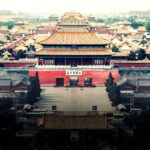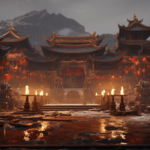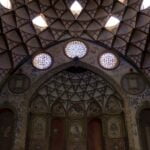The art of the Han Dynasty holds a significant place in Chinese history. Spanning over four centuries, from 206 BC to 220 AD, the Han Dynasty witnessed remarkable advancements in various art forms. This article explores the art styles of the Han Dynasty, highlighting their philosophy, burial goods, architecture, and the impact of the era on world history.
Explore the rich artistry of the Han Dynasty (206 BCE-220 CE) in our article on Han Dynasty Art Styles. Discover the captivating world of artistic expression during this remarkable era!
1. Han Dynasty Art
During the Han Dynasty, art became an important means of self-expression and a reflection of the society’s values. The art of this era focused on depicting everyday life, nature, and the relationship between humans and the divine. The artists of the Han Dynasty crafted intricate sculptures, pottery, and paintings that showcased their creativity and artistic skills.
2. Philosophy and Art of the Han Dynasty
The art of the Han Dynasty was deeply influenced by the philosophical beliefs of the time, particularly Confucianism and Daoism. Confucianism emphasized moral values, filial piety, and social harmony, which were often depicted in Han Dynasty artworks. Daoism, on the other hand, emphasized the harmony between humans and nature, leading to the portrayal of landscapes and natural elements in Han Dynasty art.
3. Burial Goods of the Han Dynasty
One of the remarkable aspects of Han Dynasty art was its association with burial practices. The wealthy and elite individuals of the Han Dynasty believed in the afterlife and the importance of providing the deceased with luxurious items. Intricate jade carvings, beautifully crafted ceramics, and stunning bronze figurines were among the burial goods commonly found in Han Dynasty tombs.
4. Architecture of the Han Dynasty
The architecture of the Han Dynasty showcased the grandeur and craftsmanship of the era. The Han Dynasty is known for its magnificent palaces, temples, and tombs. The architectural style of this era combined elements of both traditional Chinese and Western Han influences. The use of wooden structures, colorful roof tiles, and intricate carvings characterized Han Dynasty architecture.
5. Han Dynasty Ends
Despite its advancements, the Han Dynasty faced numerous challenges, including political instability and economic decline. The dynasty eventually fell due to internal conflicts, peasant uprisings, and external invasions. The end of the Han Dynasty marked a significant turning point in Chinese history.
6. Eastern Han Palace Wars
During the Eastern Han period, intense power struggles erupted within the imperial court. The palace wars were characterized by political machinations, assassinations, and military clashes for control over the throne. These conflicts had a profound impact on the art and culture of the Han Dynasty, as the ruling elite sought to legitimize their power through artistic patronage.
7. Invention of Paper
One of the most groundbreaking inventions of the Han Dynasty was the creation of paper. Cai Lun, a eunuch of the Han Dynasty, is credited with developing the paper-making process using mulberry bark, hemp, and other plant fibers. The invention of paper revolutionized communication, education, and the dissemination of knowledge, making it an essential part of Han Dynasty culture.
8. Innovations in Writing
In addition to paper, the Han Dynasty witnessed significant advancements in writing. The invention of the brush and ink, coupled with the development of standardized scripts, brought about a revolution in Chinese calligraphy. Calligraphers of the Han Dynasty perfected their skills in writing characters with elegant strokes, contributing to the development of a distinctive Han style of calligraphy.
9. Han Dynasty Timeline
To understand the art styles of the Han Dynasty, it is essential to grasp the timeline of significant events. The Han Dynasty is divided into two main periods: the Western Han (206 BC – 9 AD) and the Eastern Han (25 – 220 AD). The Western Han period is characterized by stability and prosperity, while the Eastern Han period witnessed internal strife and eventually led to the collapse of the dynasty.
10. 10 Inventions From China’s Han Dynasty That Changed the World
The Han Dynasty was a period of remarkable innovation in which numerous inventions emerged that had a lasting impact on the world. Some of these inventions include the compass, paper, the water clock, the seismograph, and the horse collar. These inventions not only shaped the history of China but also influenced global advancements.
Han Dynasty Art: A Window Into Chinese Cultural Identity
[youtube v=”Rtwu-pRBOfA”]
The Han Dynasty, spanning from 206 BCE to 220 CE, holds a significant place in Chinese history and art. This dynasty, which ruled over China for 400 years, marked an epochal turning point in Chinese cultural consolidation and reinvention. Unlike the previous dynasties, the Han Dynasty introduced art that directly expressed Confucian and Taoist ideals. While art during this period still primarily served the purpose of tombs and ancestral rituals, there was a shift in production that began to relate to the world of the court.
One notable aspect of Han Dynasty art is the introduction of painting on silk. Although very few early silk paintings have survived, they represent the most ambitious form of art in China in the coming centuries. These paintings are often associated with death and the afterlife, as they were used in complex rituals and believed to possess magical powers. For example, one artwork is a painted banner made of lacquered wood that accompanies the coffin of the Marquis of Dai. The vibrant polychrome designs of fantastic animals on the banner showcase the artistic energy of brush strokes, hinting at the quickening and animating nature of life.
Han Dynasty art also reflects the spiritual beliefs and mythocentric age of China. One notable artifact is the jade suit for a dead prince, symbolizing immortality and noble character traits. Jade, a material associated with Confucian values, expresses virtues such as charity, rectitude, wisdom, courage, and equity. The symbolic meaning attached to materials underscores the philosophical ideas influenced by both Taoism and Confucianism.
During the Han Dynasty, Confucianism became the official ideology of the imperial system. To attain important government office, individuals were required to memorize Confucius’s teachings and demonstrate their understanding. Additionally, the dynasty expanded its control over territories and outposts in Central Asia to fortify the Silk Road, leading to extensive trade with the Roman Empire. The Roman fascination with Chinese silk posed economic concerns for the Romans, leading to attempts to limit silk imports.
Lastly, the Han Dynasty’s influence extended beyond China’s borders. Colonies were established in Korea, solidifying China’s dominant relationship with its neighboring country. The establishment of colonies and trade networks served to strengthen China’s influence and secure its position as a major world power comparable to Ancient Rome.
In summary, the art of the Han Dynasty reflects a vibrant cultural identity rooted in the tenets of Confucianism and Taoism. The shift in artistic production, from primarily serving tombs to representing court life, captures the evolving dynamics of Chinese society during this period. The symbolic meanings associated with materials, such as jade, further underline the philosophical ideas and values that shaped Chinese art during the Han Dynasty.
Conclusion
The art styles of the Han Dynasty exemplify the creativity and ingenuity of the time. From its philosophical roots to its burial customs, architecture, and technological advancements, the Han Dynasty left a profound legacy in the world of art. Understanding the Han Dynasty’s art styles provides insights into the cultural, social, and political landscapes of ancient China.
FAQs (Frequently Asked Questions):
- What are the main art forms of the Han Dynasty?
The main art forms of the Han Dynasty include sculpture, pottery, painting, calligraphy, and architecture. - How did philosophy influence Han Dynasty art?
Philosophies like Confucianism and Daoism influenced Han Dynasty art by shaping its themes, such as moral values, social harmony, and the connection between humans and nature. - What role did burial goods play in Han Dynasty art?
Burial goods were an integral part of Han Dynasty art as they were believed to provide comfort and luxury to the deceased in the afterlife. - What were the significant architectural achievements of the Han Dynasty?
The Han Dynasty is known for its grand palaces, temples, and tombs, showcasing the architectural prowess and craftsmanship of the era. - How did the inventions of the Han Dynasty impact the world?
Inventions like paper, the compass, and the seismograph revolutionized communication, navigation, and scientific understanding, leaving a lasting impact on the world.
- Unveiling the Enigma: Mansoureh Khojasteh Bagherzadeh’s Public Appearances & Private Life in Iran - July 18, 2025
- Unveiling the Mystery: Mansoureh Khojasteh Bagherzadeh’s Husband: A Rare Glimpse into a Private Life - July 18, 2025
- Unveiling Masoud Khamenei’s Mother: Power, Influence, and Iran’s Future - July 18, 2025
















